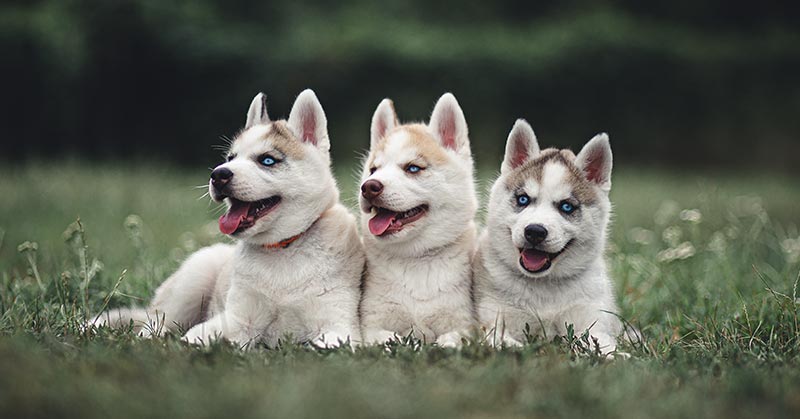The Siberian Husky, with its wolf-like appearance, striking blue eyes, and impressive endurance, is a breed that captures the imagination like no other. It’s easy to fall in love with a Siberian Husky puppy at first sight, but it’s essential to understand this breed’s needs and characteristics.
If you’re thinking about bringing one into your family or are simply curious, let’s dive deep into the world of Siberian Husky puppies!
Origin and History
Siberian Huskies hail from the icy and snow-covered realms of Siberia in northeastern Russia. The Chukchi people, Siberia’s indigenous tribe, initially bred these dogs for sled pulling and companionship. Due to their robust constitution, they could pull moderate loads over long distances while consuming minimal food.
Physical Characteristics
A Siberian Husky puppy grows into a medium-sized adult dog, typically weighing between 35-60 pounds. They have a thick double coat that can come in a variety of colors, including black, grey, and red. One of the breed’s most iconic features is its almond-shaped eyes, which can be blue, brown, green, or even one of each (called heterochromia).
Temperament
Huskies are known for their friendly and gentle temperament. They are very sociable and love being part of a pack – whether it’s with other dogs or their human family. Siberian Huskies are also incredibly intelligent, which can sometimes manifest as stubbornness, especially if they’re not mentally stimulated.
Despite their wolf-like appearance, they don’t make great guard dogs because they’re usually friendly with strangers.
Training and Socialization
Like any puppy, Siberian Huskies benefit significantly from early socialization. Enrolling them in a puppy kindergarten class is an excellent first step. Consistent training is also crucial due to their independent nature. Using positive reinforcement techniques works wonders.
Exercise Needs
Siberian Huskies are a high-energy breed that requires regular and strenuous exercise. They’re happiest when they have a job to do, like pulling a sled or engaging in agility courses. Long daily walks, combined with play sessions or a good run, will keep them content.
Without adequate exercise, they might become bored, leading to destructive behaviors.
Grooming
Thanks to their Arctic origins, Siberian Huskies have a dense double coat to protect them from the cold. They typically “blow” their undercoat twice a year, which means shedding heavily. During these periods, daily brushing will help manage the shedding. Otherwise, regular weekly grooming should suffice.
Health Considerations
While Siberian Huskies are generally healthy, they can be prone to certain genetic health issues. Regular vet check-ups, a balanced diet, and proper exercise are essential to ensure they live a long and healthy life.
Are Siberian Husky Puppies Right for You?
If you’re active, have the time and patience for training, and can provide ample space for your Husky to play and exercise, this might be the right breed for you. However, if you’re looking for a low-energy lap dog or a fierce guard dog, you might want to consider other breeds.
The Siberian Husky Puppies Barking Guide is a must-read article for Husky owners.
Final Thoughts
In conclusion, Siberian Husky puppies are a joy to raise. They’re energetic, loving, and incredibly loyal. With the right care, training, and understanding of their needs, they can be a delightful addition to the family.
Like any commitment, it’s crucial to do your research and ensure that you’re ready for the responsibility that comes with raising such an active and intelligent breed.
FAQs on Siberian Husky Puppies
Q: How often do Siberian Husky puppies need to be fed?
A: In their initial weeks, Siberian Husky puppies should be fed 3-4 times a day. As they grow older, you can gradually reduce this to two meals a day by adulthood.
Q: Are Siberian Huskies suitable for apartment living?
A: While it’s possible to keep a Siberian Husky in an apartment, it’s not ideal unless you can provide them with ample exercise daily. They are active dogs that thrive in open spaces.
Q: How do I train my Siberian Husky puppy not to bite?
A: Early socialization and positive reinforcement training methods are key. When they bite, offer a toy instead and praise them when they chew on appropriate items.
Q: How cold is too cold for a Siberian Husky?
A: Siberian Huskies have a thick double coat that provides insulation against extreme cold. However, prolonged exposure to temperatures below -20°F (-29°C) can be harmful, especially for puppies.
Q: Are Siberian Huskies hypoallergenic?
A: No, Siberian Huskies are not hypoallergenic. They have a dense double coat and shed regularly, which can trigger allergies in sensitive individuals.
Q: What’s the average lifespan of a Siberian Husky?
A: With proper care and a healthy lifestyle, Siberian Huskies typically live between 12 to 15 years.
Q: Can Siberian Huskies live in hot climates?
A: While Siberian Huskies are bred for cold climates, they can adapt to warmer temperatures if they are kept in cool indoor spaces during peak heat. It’s also essential to ensure they have plenty of water and avoid strenuous exercise during the hottest parts of the day.
Q: Do Siberian Huskies get along with other pets?
A: Generally, Siberian Huskies are sociable and can get along with other dogs. However, due to their high prey drive, they might chase smaller animals like cats or birds unless socialized with them from a young age.
Q: How often should I groom my Siberian Husky puppy?
A: Regular weekly brushing should suffice, but during their shedding season (when they “blow” their undercoat), daily brushing can help manage the loose fur.
Q: Are Siberian Huskies easy to train?
A: Siberian Huskies are intelligent, but they also have an independent streak. With consistency, patience, and positive reinforcement methods, they can be trained effectively.



